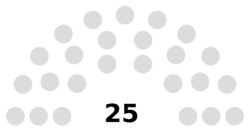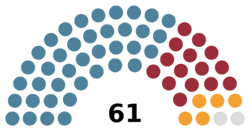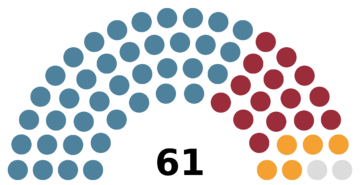Mava Council: Difference between revisions
No edit summary |
No edit summary |
||
| Line 48: | Line 48: | ||
| session_room = Territorial Legislature Yellowknife Northwest Territories Canada 03.jpg | | session_room = Territorial Legislature Yellowknife Northwest Territories Canada 03.jpg | ||
| session_res = 260px | | session_res = 260px | ||
| session_alt = The seat of the legislature is the | | session_alt = The seat of the legislature is the Kausaakkavtaagikakitat in Paas | ||
| website = {{plain list| | | website = {{plain list| | ||
*[https://i.imgur.com/LJrd3HN.jpg/ Nominated Assembly - official website] | *[https://i.imgur.com/LJrd3HN.jpg/ Nominated Assembly - official website] | ||
| Line 55: | Line 55: | ||
|structure2_res=250px|structure1_res=250px}} | |structure2_res=250px|structure1_res=250px}} | ||
{{Politics of Mava}} | {{Politics of Mava}} | ||
The '''Parliament of the | The '''Parliament of the Commonwealth of Mava''' ([[Mavean language|Mavean]]: ''Kausaakkavtaagik''; <small>lit.</small> Lawmakers) is the bicameral legislature of [[Mava]], consisting of the Nominated Assembly (''Okiigokaiqaawnuktaagik'') and the Legislative Assembly (''Kausaakkavakak''). Both chambers meet at the Kausaakkavtaagikakitat in Paas. | ||
Parliament | The current Parliament was established in the 1925 Constitution, replacing the colonial-era Legislative Council. The Council was established by the Atitlanese colonial authorities in 1908 to advise the governor in policymaking. The council did not have the power of veto and had only a consultative role, with no power to even propose legislation. In 1925, upon independence, the Council was replaced with the current Parliament. Between 1925 and 1943, the Parliament was largely subordinate to the personalist regime of Kuraava Tanigak. Following constitutional amendments in 1943, which replaced the presidential system with a parliamentary system, Parliament assumed exclusive control over the legislative power and also took over nominal executive powers. | ||
The members of the Legislative Assembly are elected for two years via first-past-the-post. Members represent multi-member constituencies (apart from Taagokiajut, which has a single-member at-large constituency). The 25 members of the Nominated Assembly are appointed by the President-in-Council on the advice of the Joint Committee on Appointments, a body composed of members of both houses. For laws to pass, they must receive the approval of the Legislative Assembly and must be confirmed to be lawful and constitutional by the Nominated Assembly. | |||
==History== | ==History== | ||
The Parliament of Mava was created on 1 April 1925 through the Mavean Independence Act, passed by the Atitlanese Congress. The members were carried over from the membership of the Legislative Council, which had served as the appointed advisory body to the colonial governor. Under the interim provisions, Mava was governed by a Transitional Government of the Parliament, appointed by Parliament to govern until elections could be held. The first elections were held on 14 May 1925, with Kuraava Tanigak appointed president by Parliament. The body was made permanent following the passage of the first Mavean constitution in September 1925. | The Parliament of Mava was created on 1 April 1925 through the Mavean Independence Act, passed by the Atitlanese Congress. The members were carried over from the membership of the Legislative Council, which had served as the appointed advisory body to the colonial governor. Under the interim provisions, Mava was governed by a Transitional Government of the Parliament, appointed by Parliament to govern until elections could be held. The first elections were held on 14 May 1925, with Kuraava Tanigak appointed president by Parliament. The body was made permanent following the passage of the first Mavean constitution in September 1925, with the division of its powers between the newly established Nominated Assembly and Legislative Assembly. | ||
The 1943 constitution radically increased the powers of parliament, transforming Mava from a presidential to a parliamentary republic. The prime minister, a member of | The 1943 constitution radically increased the powers of parliament, transforming Mava from a presidential to a parliamentary republic. The prime minister, a member of the Legislative Assembly, formally became head of government and answerable to the Legislative Assembly rather than the president. The Legislative Assembly also assumed powers to dismiss governments with the abolition of the assembly-independent system, and its members became the sole initiators of legislation, with the president previously able to propose bills. The Nominated Assembly had its power of veto removed, now only able to recommend amendments and supervise the drafting of laws. It remains responsible for ensuring the legality of any laws passed in the lower house. | ||
Under the 1943 constitution, the president of the parliament appointed a "Grand Committee of the Parliament", composed of | Under the 1943 constitution, the president of the parliament appointed a "Grand Committee of the Parliament", composed of members of both houses appointed for the purpose of electing the president and approving the nominations of judges and other officials. The body was abolished in 1994; a Parliamentary Convention was created to elect the president, whilst responsibility for approving nominations was transferred to the Legislative Assembly. | ||
==Powers and role== | ==Powers and role== | ||
Revision as of 20:47, 1 July 2023
 |
|---|
| This article is part of a series on the politics and government of Mava |
|
The Parliament of the Commonwealth of Mava (Mavean: Kausaakkavtaagik; lit. Lawmakers) is the bicameral legislature of Mava, consisting of the Nominated Assembly (Okiigokaiqaawnuktaagik) and the Legislative Assembly (Kausaakkavakak). Both chambers meet at the Kausaakkavtaagikakitat in Paas.
The current Parliament was established in the 1925 Constitution, replacing the colonial-era Legislative Council. The Council was established by the Atitlanese colonial authorities in 1908 to advise the governor in policymaking. The council did not have the power of veto and had only a consultative role, with no power to even propose legislation. In 1925, upon independence, the Council was replaced with the current Parliament. Between 1925 and 1943, the Parliament was largely subordinate to the personalist regime of Kuraava Tanigak. Following constitutional amendments in 1943, which replaced the presidential system with a parliamentary system, Parliament assumed exclusive control over the legislative power and also took over nominal executive powers.
The members of the Legislative Assembly are elected for two years via first-past-the-post. Members represent multi-member constituencies (apart from Taagokiajut, which has a single-member at-large constituency). The 25 members of the Nominated Assembly are appointed by the President-in-Council on the advice of the Joint Committee on Appointments, a body composed of members of both houses. For laws to pass, they must receive the approval of the Legislative Assembly and must be confirmed to be lawful and constitutional by the Nominated Assembly.
History
The Parliament of Mava was created on 1 April 1925 through the Mavean Independence Act, passed by the Atitlanese Congress. The members were carried over from the membership of the Legislative Council, which had served as the appointed advisory body to the colonial governor. Under the interim provisions, Mava was governed by a Transitional Government of the Parliament, appointed by Parliament to govern until elections could be held. The first elections were held on 14 May 1925, with Kuraava Tanigak appointed president by Parliament. The body was made permanent following the passage of the first Mavean constitution in September 1925, with the division of its powers between the newly established Nominated Assembly and Legislative Assembly.
The 1943 constitution radically increased the powers of parliament, transforming Mava from a presidential to a parliamentary republic. The prime minister, a member of the Legislative Assembly, formally became head of government and answerable to the Legislative Assembly rather than the president. The Legislative Assembly also assumed powers to dismiss governments with the abolition of the assembly-independent system, and its members became the sole initiators of legislation, with the president previously able to propose bills. The Nominated Assembly had its power of veto removed, now only able to recommend amendments and supervise the drafting of laws. It remains responsible for ensuring the legality of any laws passed in the lower house.
Under the 1943 constitution, the president of the parliament appointed a "Grand Committee of the Parliament", composed of members of both houses appointed for the purpose of electing the president and approving the nominations of judges and other officials. The body was abolished in 1994; a Parliamentary Convention was created to elect the president, whilst responsibility for approving nominations was transferred to the Legislative Assembly.
Powers and role
Under the constitution, there is no legal or constitutional separation between the executive and legislative branches. The government is officially called the "Executive Committee of the Parliament" and derives its powers from Parliament. In practice, there is a separation of functions, although officially the government and parliament constitute one single corporation governed by the constitution and relevant laws.
The Parliament is constituted in the Constitution as the supreme representative body of the people of the Republic of Mava. It is convened in two sessions each year, the first session on the second Monday of January and the second session on the second Monday of September. Extraordinary sessions may be called by the President, the Prime Minister or by one-fifth of members.
The constitution and laws relating to Parliament provide for the following functions:
- Adopting, amending, or repealing enactments to the constitution;
- enacting, amending, or repealing statutory laws;
- approve the budget;
- elect the president;
- approve nominations for judicial offices and appointments to the Council of State;
- approving the nomination of the prime minister;
- hold the government to account;
- convene as a court of impeachment for trials of public officers;
- approve international treaties.
The president's role in the legislative branch is nominal. They summon and dissolve Parliament and formally open its sessions following an election. They may address its members and send messages to it. However, they are obliged (although not legally required) to sign laws passed in the Assembly; they may refer laws for judicial review, but this is rarely done.
Elections
General elections occur whenever Parliament is dissolved. Dissolutions occur automatically two years from the date of the first meeting of Parliament, although it is common for dissolutions to occur in March, at least six weeks prior to the date of the next election. Elections are usually held in the second week of May (generally a Thursday), following an electoral campaign of no less than 35 days. Candidates are usually nominated by political parties, although a small number of independent candidates have won seats. Candidates are usually elected in local party meetings in the relevant constituency, although the law does not mandate this and several candidates have historically been selected by the national party rather than local members.
Candidates are required to file a nomination paper bearing the signatures of at least 50 constituents. Each constituency returns one member of Parliament using the first-past-the-post electoral system, under which the winning candidate needs only the plurality of the vote instead of an outright majority. To stand as and vote for a candidate, one must be a Mavean citizen and at least eighteenth years of age. Additional eligibility requirements are imposed on electoral candidates.
Members serve a two year term. Should a member die, resign, or otherwise cease to hold their seat, a by-election is held in the relevant constituency under the same rules and procedures as in general elections. Individuals expelled by Parliament are not permitted to run in the following by-election, although they may be a candidate in the next general election (even if no subsequent by-election is held).
Constituencies
61 members are returned from multi-member constituencies or single-member constituencies. Each district is divided into a number of seats based on their population, each returning an allocated number of members. The distribution of constituencies is reviewed every ten years by the Mavean Elections Office.
| District | Seats | MPs |
|---|---|---|
| Aasqaalet | 2 | 11 |
| Miilep | 2 | 12 |
| Paas | 4 | 23 |
| Pmaak | 3 | 6 |
| Sigaak | 2 | 4 |
| Sittiyaa | 1 | 2 |
| Taagokiajut | 1 | 1 |
| Outer Islands | 1 | 2 |
The current set of constituency boundaries came into effect ahead of the May 2015 parliamentary elections. Prior to this, Paas had 6 seats, which were re-allocated to Aasqaalet and Pmaak.
2023 election
See also
- Politics of Mava
- Culture of Mava
Notes
External links
- Parliament of Mava. aawnuhiuakak.mv




